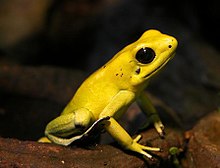Golden poison frog
| Phyllobates terribilis | |
|---|---|
 |
|
| Scientific classification | |
| Kingdom: | Animalia |
| Phylum: | Chordata |
| Class: | Amphibia |
| Order: | Anura |
| Family: | Dendrobatidae |
| Genus: | Phyllobates |
| Species: | P. terribilis |
| Binomial name | |
|
Phyllobates terribilis , , and , 1978 |
|
The golden poison frog (Phyllobates terribilis), also known as the golden frog, golden poison arrow frog, or golden dart frog, is a poison dart frog endemic to the Pacific coast of Colombia. The optimal habitat of P. terribilis is the rainforest with high rain rates (5 m or more per year), altitudes between 100 and 200 m, temperatures of at least 26 °C, and relative humidity of 80–90%. In the wild, P. terribilis is a social animal, living in groups of up to six individuals; however, captive P. terribilis specimens can live in much larger groups. These frogs are often considered innocuous due to their small size and bright colours, but wild frogs are lethally toxic.
The golden poison frog is endemic to humid forests of the Pacific coast of Colombia in the Cauca and Valle del Cauca Departments. Its range is less than 5,000 square km. It is only known from primary forest. The eggs are laid on the ground; the males transport the tadpoles to permanent pools.
P. terribilis is the largest species of poison dart frog, and can reach a size of 55 mm as adults, with females typically being larger than males. Like all poison dart frogs, the adults are brightly colored, but they lack the dark spots present in many other dendrobatids. The frog's colour pattern is aposematic (which is a warning coloration to warn predators of its toxicity). The frog has tiny adhesive disks on its toes, which aid climbing of plants. It also has a bone plate in the lower jaw, which gives it the appearance of having teeth, a distinctive feature not observed in the other species of Phyllobates. The frog is normally diurnal. P. terribilis occurs in three different color varieties or morphs:
The largest morph of P. terribilis exists in the La Brea area of Colombia, and is the most common form seen in captivity. The name "mint green" is actually rather misleading, as the frogs of this morph can be metallic green, pale green, or white.
...
Wikipedia

